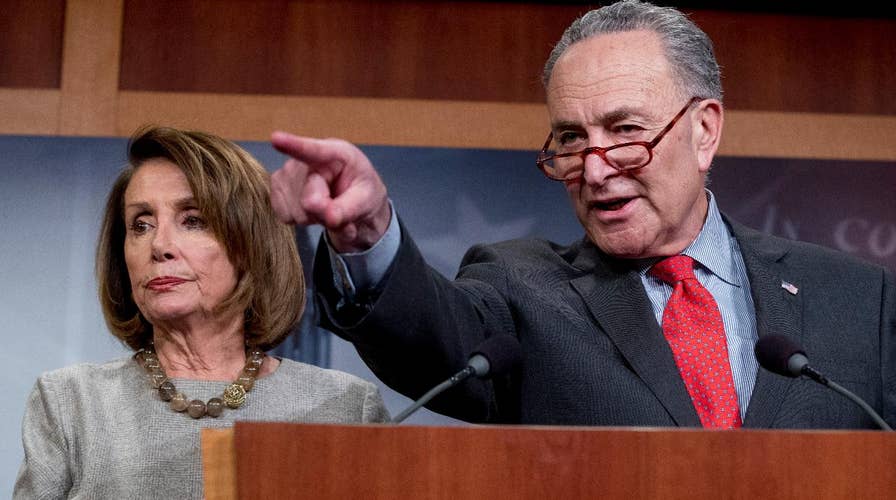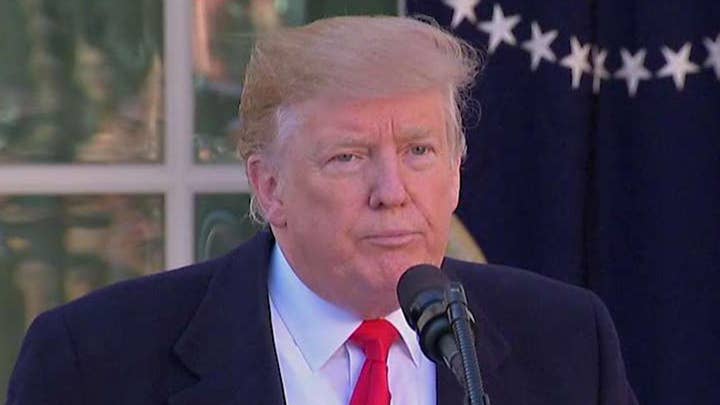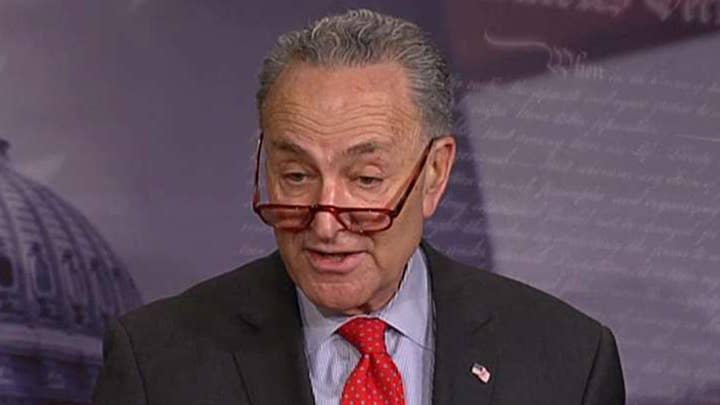Are Democrats celebrating the shutdown standoff as a win too early?
Former Mike Pence press secretary Marc Lotter and democratic strategist Jason Nichols weigh in on what compromises both parties will make in a new border security deal.
Does anyone really think we won’t be back here in three weeks, trying to avert another crisis and fund the government?
“If the Democrats come in offering $0 for the wall at the beginning and $0 for the wall at the end, that’s not a negotiation,” said one Republican.
FEDERAL EMPLOYEES RETURN TO WORK AFTER LONGEST-EVER SHUTDOWN – BUT FOR HOW LONG?
Well, you all know that’s not true. After all, House Speaker Nancy Pelosi, D-Calif., said long ago she’d offer “$1” for the wall.
So….
But why does the Trump administration and GOP advocates on Capitol Hill think congressional Democrats will budge?
If the president agreed to re-open the government after achieving nothing and Republicans started taking the blame, why does the president think the matrix changes in mid-February? Democrats gave nothing. They have very little to lose in the next round.
“I can’t imagine that (President Trump) is in any stronger position than he was now that he’s had to move off his position,” Rep. Francis Rooney, R-Fla., recently said on Fox News.
TRUMP SIGNS BILL TO END PARTIAL GOVERNMENT SHUTDOWN
The key to the three-week window is a conference committee, a blend of bipartisan House and Senate negotiators, charged with forging a border security agreement before Feb. 15. Otherwise, we might be right back where we were.
Pelosi lifted an exchange of DACA for a wall off the table. What really could Democrats trade? Comprehensive immigration reform? There’s almost no way lawmakers could settle something of that magnitude in less than three weeks. Plus, the scope of the conference committee is narrow in terms of both substance and time. The administration likes the confined turning radius. But it really doesn’t give the sides much to negotiate. House Majority Leader Steny Hoyer, D-Md., told Fox News on Friday that Democrats want to complete a DACA fix and approve comprehensive immigration reform. But Hoyer noted the conference committee doesn’t have to untangle those issues. The Maryland Democrat said Congress can address them later.
TRUMP DOUBTS HE'D ACCEPT ANY DEAL CONGRESS STRIKES FOR BORDER WALL
There’s a reason the government shut down in the fall of 1995 during an epic standoff between President Bill Clinton and House Speaker Newt Gingrich re-opened later, and then shut down again. The sides thought they were on a track to resolve their issues. But they weren’t.
That said, there is opportunity here. A crisis like the one over the government shutdown could spur policymakers to action. Big crises often prompt landmark agreements. Such was the case with the mid-‘90s deadlock between Clinton and Gingrich. The shutdowns sparked a major deal on federal spending and prompted welfare reform. The 2011 quandary over the debt ceiling resulted in $1.1 trillion in discretionary spending cuts via sequestration. History shows an agreement is feasible.
Senate Majority Leader Mitch McConnell, R-Ky., long doubted there would be a shutdown the first time. We’ll see how confident McConnell is now.
“There is no education in the second kick of a mule,” McConnell is fond of saying.
Optimists on the Republican side are betting on a couple of factors.
A LOOK BACK AT EVERY GOVERNMENT SHUTDOWN IN US HISTORY
It’s likely Congress and the White House will reschedule State of the Union for February 5. After the president punted last week, Rep. Dan Kildee, D-Mich., observed Trump’s allocution at the White House.
“I have seen people go to the Rose Garden after a hard-won fight,” said Kildee. “I have never seen the president go to the Rose Garden and take a defeat lap.”
Republicans know the president needs a big platform. A bully pulpit with which to sell his border wall pitch. A rescheduled State of the Union is the perfect forum for that, combined with the splendor and pomp of the House chamber. With the government re-opened, Trump gets to make his appeal from the dais of the House. Right in front of Pelosi, no less. This is the State of the Union grandeur the president truly wants. Not some Make America Great Again rally with supporters stuffed into a second-rate ECHL hockey arena.
The administration and many Republicans think there are fissures in the Democratic ranks when it comes to border security or a wall. Consider the fact that Democrats now control the House because they won seats with moderate to conservative Democrats in battleground districts. Championing a wall is good politics for these members.
“(Democrats) had come to us and said ‘Look, we agree with you. You’re winning the battle on the importance of a barrier on the southern border. But we simply cannot work with you while the government is (closed),” White House Chief of Staff Mick Mulvaney said on Fox News Sunday. “I think the president saw a chance here to try and take the Democrats at their word.”
CRACKS IN BORDER WALL RESISTANCE? PELOSI FACING DEM PRESSURE TO DEAL WITH TRUMP
A vote for border security and even the four-lettered word could be smart politically for moderate Democrats. That’s why the administration thinks they can attract Democrats. But that theory runs afoul of one factor: Nancy Pelosi.
The government shutdown and stare down with Trump only emboldened Democrats. It solidified the standing of Pelosi among Democrats who were skeptical of her. The freshman House Democratic class is full of disruptors and upstarts, ready to crash the system. Rather than turning their attention on Pelosi and other “institutional problems,” the newcomers directed their ire on the president. The shutdown helped Pelosi keep Democrats together and channel energies against Trump.
This phenomenon isn’t that new. Congressional Republicans won the House in 2010. Once in control, the GOP found it was a lot easier to oppose things like President Obama and Obamacare than be for something – say a bill to actually repeal and replace Obamacare.
This is why the conference committee might not get anywhere. Opposing the president is easy for Democrats. Solving the problem is more nuanced.
Something has to give somewhere. Otherwise, we’re stuck in the same feedback loop for the next three weeks.







